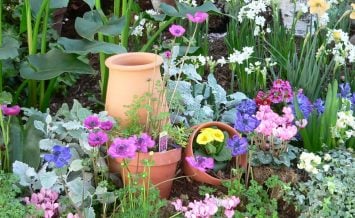From seedheads and grasses to flower skeletons: 6 plants to give your garden winter interest
Yes, the garden may look untidy now, with beds full of faded flowers and herbaceous borders past their summer flourish – but some plants come into their own in winter, providing eye-catching seedheads and colourful stems through the cooler months.
Andrew Hellman, garden manager at RHS Garden Hyde Hall, has helped create the new Winter Garden there, which focuses on herbaceous plants with striking colours and texture in the foliage and seedheads to add interest in winter.
Here are six of his top plants for adding structure and colour to the garden scene during the cooler months…
1. Hydrangea paniculata ‘Phantom’

Hydrangea paniculata seedheads
It’s not just evergreen shrubs and trees that are important for winter interest. This shrub flowers in late summer and early autumn, with conical panicles of pale pink and white flowers. The faded flowers remain on into the winter, pale puffs at the ends of darker bare stems.
“Their texture captures the low winter sun particularly well and you may be tempted to cut a few stems for the house,” Hellman observes. “Hydrangeas let you know when it is time to cut the stems back, as green leaf buds start to show in late winter. Prune to a framework of new growth, just remove the flowerheads for more but smaller blooms or to the lowest set of buds for fewer but larger blooms.”
2. Iris sibirica ‘Silver Edge’

The stems of Siberian iris turn copper in the autumn
Siberian irises produce hearty clumps of slim foliage and delicate iris flowers in shades of purple on tall stout stems. “At RHS Hyde Hall, we grow them in our winter garden less for the flowers and more for the dark seedheads, standing proud atop rich coppery stems from late summer though winter,” says Hellman.

Siberian iris in autumn
“The seedpods look like a grouping of hungry baby birds, mouths wide for food. They pair well in winter with grasses, the dark seedheads contrasting with the pale foliage of the grass. Eventually, they may collapse from snow or wind and can be clipped to leave tidy mounds of the copper foliage.”
3. Hakonechloa macra ‘Nicolas’

Potting hakonechloa into a larger pot
This low-growing grass makes neat small mounds growing only about 35cm high. It arches over gracefully and moves gently in the breeze. The cultivar Nicolas has bright red autumn colour that eventually fades to a deep golden hue.
Most people find the dried foliage irresistible to run their fingers through and it will grow in full sun to part shade and can even handle exposed locations. It looks equally good in large drifts in borders, or under raised shrubs, as it does cascading over the sides of a pot.
4. Phlomis russeliana

Phlomis russeliana
“Seedheads are a much underused feature of gardens in winter,” says Hellman. “Turkish sage is a tough plant for a sunny position, with large hairy leaves and stems of pale yellow flowers. It’s these stems and seedheads that make this a key plant in any winter planting.”
Stout, with several whorls of seedheads, each emerging out of the previous to 90cm high, make this plant look like it was designed by Dr Seuss. The seedheads glisten when touched by frost and stand firm as birds hang from the stems to feast on the seeds. Phlomis holds its own in a border, growing well between shrubs, and its weed-smothering foliage makes it a great addition to a low-maintenance planting scheme.
5. Panicum virgatum ‘Northwind’

Panicum virgatum ‘Northwind’
Grasses are brilliant for winter interest, and this switchgrass cultivar is one of the best. It grows very upright to 1.5m without flopping. Pink flowers are followed by clear yellow autumn colour and, finally, pale winter foliage. Its columnal shape and clear base make it good to use in a formal planting design, or as an architectural accent in looser planting. Underlighting would look particularly striking with this grass.
“It grows quite densely and makes a wonderful rustle when the wind blows through it,” adds Hellman. “It will happily stand through March when it needs to be cut down to allow the new growth to take over.”
6. Datisca cannabina
View this post on InstagramStunning tree 😍😍😍 #datiscacannabina #stoppedmeinmytracks #wow #fairytaletree #falsehemp
An unusual plant where space allows, datisca has tall upright stems with fine foliate growing 2m or more. The stems arch over at the tips with tassels of greenish white flowers. They retain these stems and tassels through the winter with a ghostly appearance as they dry.
The tall stems have plenty of space between them, allowing you to see whatever is planted behind. “They pair well with lower plants,” notes Hellman, “such as the dense heads of stonecrops (Hylotelephium ‘Herbstfreude’) in a border.”
The Press Association
Latest posts by The Press Association (see all)
- Could brisk walking boost your heart? - April 16, 2025
- Best spring-to-summer plants to fill the colour gaps - April 15, 2025
- Catherine tells how ‘spiritual’ connection with nature gives her peace in busy world - April 15, 2025
- Why weeds are worth cultivating – and eating - April 14, 2025
- 5 top tips for cleaning your tech, from phones to laptops - April 14, 2025




















